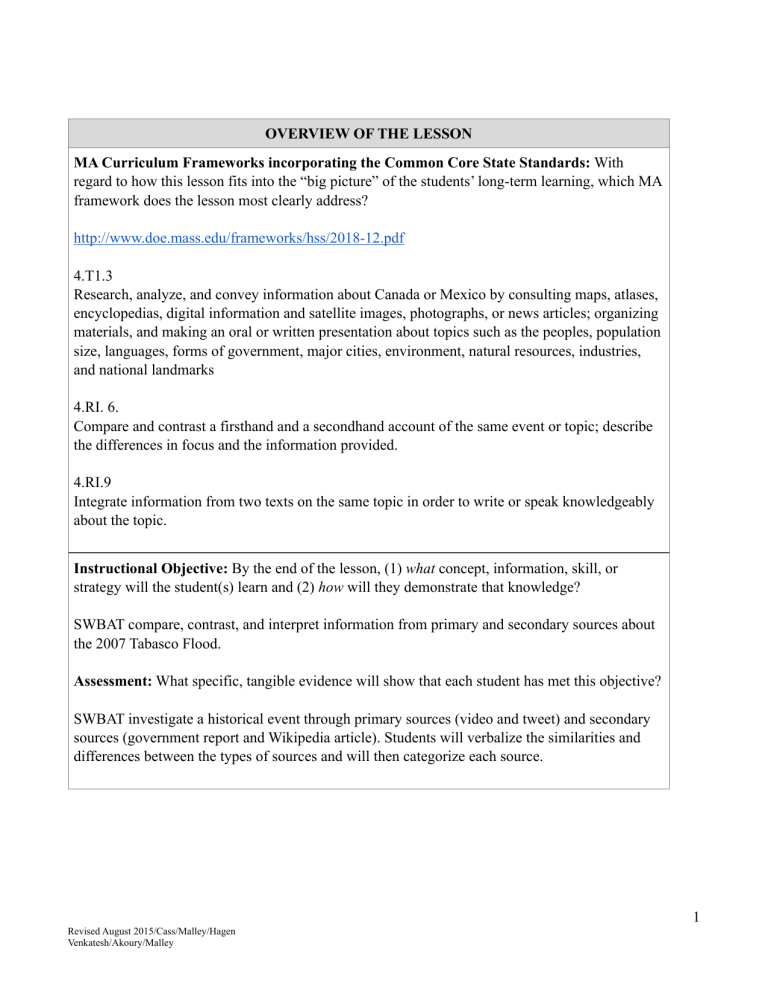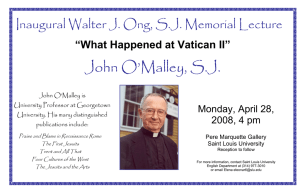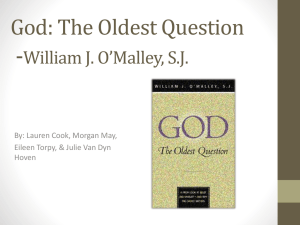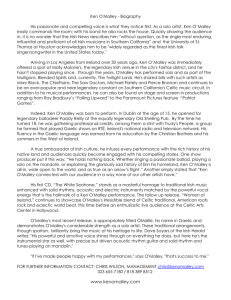FREEPrimaryandSecondarySourcesCOMPLETEUDLLessonPlanandSlides-1
advertisement

OVERVIEW OF THE LESSON MA Curriculum Frameworks incorporating the Common Core State Standards: With regard to how this lesson fits into the “big picture” of the students’ long-term learning, which MA framework does the lesson most clearly address? http://www.doe.mass.edu/frameworks/hss/2018-12.pdf 4.T1.3 Research, analyze, and convey information about Canada or Mexico by consulting maps, atlases, encyclopedias, digital information and satellite images, photographs, or news articles; organizing materials, and making an oral or written presentation about topics such as the peoples, population size, languages, forms of government, major cities, environment, natural resources, industries, and national landmarks 4.RI. 6. Compare and contrast a firsthand and a secondhand account of the same event or topic; describe the differences in focus and the information provided. 4.RI.9 Integrate information from two texts on the same topic in order to write or speak knowledgeably about the topic. Instructional Objective: By the end of the lesson, (1) what concept, information, skill, or strategy will the student(s) learn and (2) how will they demonstrate that knowledge? SWBAT compare, contrast, and interpret information from primary and secondary sources about the 2007 Tabasco Flood. Assessment: What specific, tangible evidence will show that each student has met this objective? SWBAT investigate a historical event through primary sources (video and tweet) and secondary sources (government report and Wikipedia article). Students will verbalize the similarities and differences between the types of sources and will then categorize each source. 1 Revised August 2015/Cass/Malley/Hagen Venkatesh/Akoury/Malley Academic Language Objective: By the end of the lesson, (1) what language, relating to the lesson and lesson content, will the student(s) know or learn, and (2) how will they demonstrate that knowledge? Refer to WIDA and Three Tiers of Vocabulary Beck, Kucan, and McKeown (2002) as cited by Thaashida L. Hutton in Three Tiers of Vocabulary and Education. Tier 3 Vocabulary Primary Source Primary sources are original documents, images or artifacts that provide direct evidence about a historical topic. Secondary Source Secondary sources interpret and analyze primary sources. These sources are one or more steps removed from the event. Tabasco Flood of 2007 ● The 2007 Tabasco flood occurred in late October and early November 2007 in the Mexican states of Tabasco and Chiapas. ● At least 20,000 people were forced to seek emergency shelter. ● Over 1,000,000 residents were affected. Assessment: What specific, tangible evidence will show that each student has met this objective? SWBAT collaboratively complete a Venn diagram for primary and secondary sources. Furthermore, students will identify examples of primary and secondary sources. Content: What are the specific details of the lesson’s content knowledge? SWBAT take part in a “moving debate”. Students will articulate whether they believe primary or secondary sources are more important and defend their reasoning using their background knowledge, notes, and information learned during the lesson. PROCEDURES FOR THE LESSON In this section, provide specific directions, explanations, rationales, questions, potential vignettes/ scenarios, strategies/methods, as well as step-by-step details that could allow someone else to effectively teach the lesson and meet the lesson objectives. 2 Revised August 2015/Cass/Malley/Hagen Venkatesh/Akoury/Malley Opening (_10_ minutes): How will you introduce the instructional objective to the students, “activate” learners, pre-teach/ preview vocabulary, and prepare them to engage with the lesson content? Teacher will read the title slide. “Primary and secondary sources give us different information about an event, person, or place”. Teacher will review small group expectations. Students will raise hands and remind each other of these expectations. Teacher will call on a student to read the quote of the day. “What did Mr. John Franklin mean when he said this? Today we are going to find out!”. This quote will pique students’ interests. Teacher will pass out clipboards with students’ notebook attached. 3 Revised August 2015/Cass/Malley/Hagen Venkatesh/Akoury/Malley During Lesson (30 minutes): How will you direct, guide, and/or facilitate the learning process to support the students in working toward meeting the instructional objectives? Primary Source: The teacher will call on a student to read the definition. Each student will copy the definition into his or her notebook. After teacher will pose questions about the pictures. Teacher will remind students that they learned about the native Aztec people and the Spanish conquistadors in a previous lesson. “These maps are of Mexico city. They were created by the Aztec people and the Spanish conquistadors, who we learned about a few weeks ago. How are these maps different than the maps in our textbooks?” Anticipated Student Response: ● There are different symbols. ● They only show one city. We looked at maps of the whole country. ● They look older. ● It is harder to read. ● It is made out of a different material. “Even though these maps were created during the same time, they are different. Why?” Anticipated Student Response: ● The maps had different purposes. ● The Aztec people and the Spanish conquistadors had different perspectives. ● They used different resources to make their maps. “What are some other examples of primary sources?” Anticipated Student Response: ● autobiography ● video and pictures from the event ● diary entry ● interview with a person present at the event Secondary Source: The teacher will call on a student to read the definition. Each student will copy the definition into his or her notebook. After the teacher will pose questions about the pictures. “Textbooks are examples of secondary sources. How do we know this is a secondary source?” Teacher will pass around “Mexico: The Land” so students can look through the content of the book (students are already familiar with this book as we used it two weeks ago during a lesson Revised August 2015/Cass/Malley/Hagen Venkatesh/Akoury/Malley 4 Closing (10 minutes): How will you bring closure to the lesson and, by doing so, review and determine what students have learned? Students will gather together to recap the debate. What went well? What can be improved during the next moving debate? Teacher will emphasize the importance of both primary and secondary sources. Students will have the opportunity to share what they have learned and ask lingering questions. Teacher will write these questions and address them during the next lesson. SUPPORTING ALL LEARNERS 5 Revised August 2015/Cass/Malley/Hagen Venkatesh/Akoury/Malley As you think about supporting all learners, think about the Principles of Universal Design for Learning (UDL), and utilize resources at the following links: UDL at a glance: http://www.udlcenter.org/resource_library/videos/udlcenter/udl#video0 Overview:http://www.cast.org/teachingeverystudent/toolkits/tk_procedures.cfm?tk_id=21 Lesson Plan examples http://www.cast.org/teachingeverystudent/toolkits/tk_lessons.cfm?tk_id=21 Learner Factors: What will you do to ensure the success of all students? Specifically, students on individual education plans, English language learners (at a variety of English language levels), and students who may need an extended challenge. Highlight all that apply. Grouping Factors Adjust grouping format Content Materials Student Response Seat students strategically near one another Pair students Give additional examples Provide alternate reading Provide on-level reading Write homework list Graphic organizers Use Braille or large print Use manipulatives Alternate response format (verbal/written) Give daily progress report Extend time Use assistive devices Give verbal cues to emphasize main ideas Increase the number of review activities Technology Give students a copy of directions Use interpreter Give more breaks Allow use of computer Hand out copies of notes Re-read directions Use page markers 6 Revised August 2015/Cass/Malley/Hagen Venkatesh/Akoury/Malley 7 Revised August 2015/Cass/Malley/Hagen Venkatesh/Akoury/Malley PRIMARY AND SECONDARY SOURCES QUOTE OF THE DAY “We must go beyond textbooks, go out into...the depths of the wilderness and travel and explore and tell the world the glories of our journey;” John Hope Franklin, Historian Primary Source Primary sources are original documents, images or artifacts that provide direct evidence about a historical topic. Secondary Source Secondary sources interpret and analyzes primary sources. These sources are one or more steps removed from the event. Venn Diagram Analyzing an Historical Event: Tabasco Flood of 2007 The 2007 Tabasco flood occurred in late October and early November 2007 in the Mexican states of Tabasco and Chiapas. At least 20,000 people were forced to seek emergency shelter. Over 1,000,000 residents were affected. Which sources are primary sources? Which sources are secondary sources? How do you know? Debate: Which type of source is more important? Why is it important to look at primary AND secondary sources?


